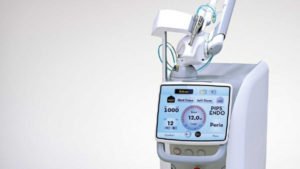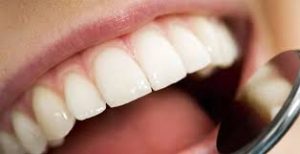
Simply put, laser dentistry uses extremely focused light beams (lasers) to remove or alter soft or hard tissues in the mouth without the uncomfortable vibration, noise or heat of a drill. These lasers come in handy for tons of different dental procedures, ranging from the reshaping of gums to teeth whitening (queue that perfect smile), but while lasers have been around for decades, many patients are only now discovering laser dentistry as an alternative to certain traditional dental practices. Feeling skeptical? Well, just imagine taking a trip to the dentist, sitting back in a comfy chair and having work done without the use of a drill. For once, you can actually hear the TV overhead!
While there are tons of reasons dentists would use laser technology, here are a couple of the most common procedures:
- Gummy Smile: Laser technology can be used to treat a “gummy smile.” This means that dentists can reshape gums if they’re covering too much of a patient’s teeth.
- Crowns: When a patient requires a crown but the dentist needs to expose more of a tooth’s surface, dentists can use a laser to recontour gum tissue and bone.
- Tooth Decay: Lasers can detect early tooth decay and kill bacteria in a cavity.
- Teeth Whitening: During teeth-whitening sessions, lasers help speed up the bleaching process.
- Sleep Apnea: Lasers are used to induce tighten the collagen in the nasal cavity to reduce snoring at night.
This All Sounds Great, But Why Pick Laser Over Regular Dentistry?
One of the biggest reasons is because laser dentistry can feel a lot less intrusive and is more gentle. Instead of using drills or heavy anesthesia, dentists use lasers to minimize patient discomfort. For example, it’s easier to control bleeding during a laser procedure and this lessens the chance a patient will need stitches (how awesome is that?) Healing times are also increased, which means you can return to your normal routine much more quickly. Finally, the light beams used in these types of procedures sterilize the surgical site, reducing the likelihood of infection!
You must be wondering how these procedures work. First of all, there are two main branches of laser dentistry: soft tissue procedures and hard tissue procedures.
-
Soft Tissue Procedures
Soft tissue lasers are used to remove or alter soft tissues in the mouth, such as the cheeks, gums, and lips. These types of lasers emit a light wavelength, which hemoglobin (the molecule found in the blood) and water can easily absorb. As these lasers cut into the soft tissue, they’re also sealing off the exposed blood vessels, which is why patients bleed less during laser procedures. Soft Tissue Laser Procedures are sought out for a number of reasons, such as treating periodontal disease (gum disease) or reshaping gums for aesthetic purposes.
-
Hard Tissue Procedures
In laser dentistry, a hard tissue laser is used primarily on teeth. These lasers emit wavelengths that can cut through the calcium phosphate found in a person’s bones and teeth. These procedures can help prepare a patient for dental fillings or be used to help reshape a patient’s teeth.

Let’s recap the benefits!
Aside from comfortably treating patients, laser dentistry comes with a number of advantages:
- Surrounding tissue suffers less damage
- The high-energy light beams used in these procedures help with blood clotting, meaning a patient is less likely to bleed during the procedure
- The light beams sterilize the surgical site, lessening the patient’s chances of infection
- Patients with dental anxiety are less easily triggered
Are there any side effects?
Well just like any common procedure, there’s a chance the patient could experience bruising and swelling. As mentioned before, there’s a very small chance the patient could suffer from an infection, though it’s much less likely with laser treatments!
How Do I Know Whether This Treatment Is Right For Me?
If you’re experiencing discomfort due to canker sores or cold sores, looking for whiter teeth, need a cavity filled or simply wish your gums looked a little different, laser treatment might be for you. The thing is, only once you and your dentist have had a chat, will your dentist know whether or not to recommend this procedure!
Next steps:
Chat with Dr. Avi Kurupati or Dr. Jo Scalzo at Park City Dental about their new laser technology, the Fotona Lightwalker!
Here’s the Official Fotona LightWalker Video:


One Reply to “What Is Laser Dentistry?”
Love the article, sounds promising…❤️
Comments are closed.